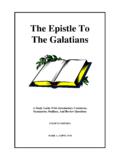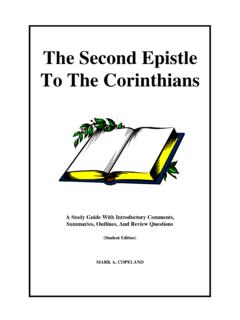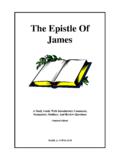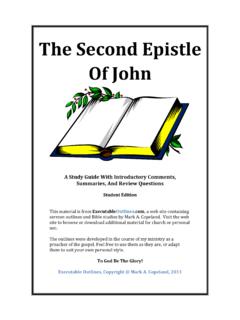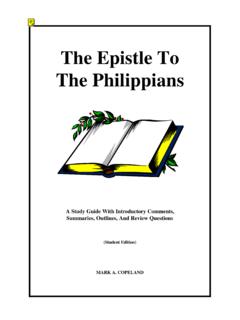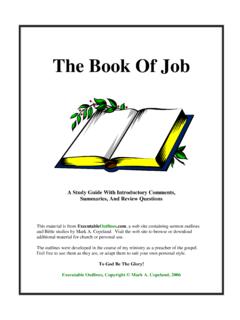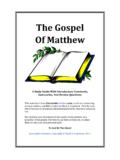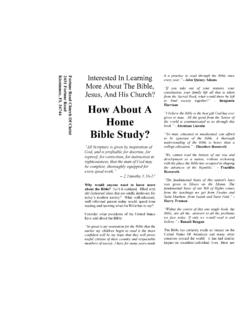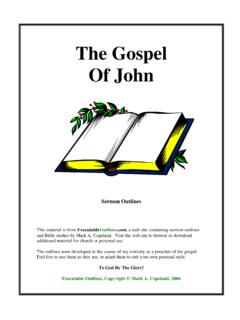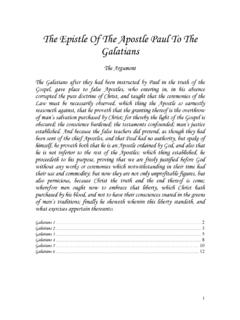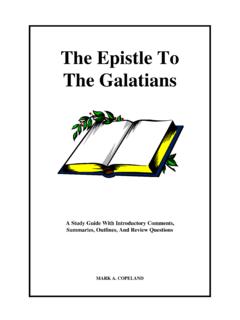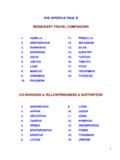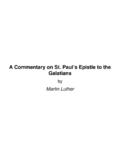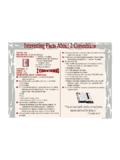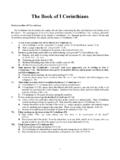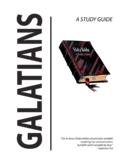Transcription of The Second Epistle To The Corinthians - Executable Outlines
1 The Second Epistle To The Corinthians A Study Guide With Introductory Comments, Summaries, Outlines , And Review Questions MARK A. COPELAND. Mark A. Copeland The Second Epistle To The Corinthians Table Of Contents Introduction 3. Chapter One 7. Chapter Two 10. Chapter Three 13. Chapter Four 16. Chapter Five 19. Chapter Six 22. Chapter Seven 25. Chapter Eight 28. Chapter Nine 31. Chapter Ten 34. Chapter Eleven 37. Chapter Twelve 40. Chapter Thirteen 43. This study guide was developed in preparation for teaching adult Bible classes. w The objectives for each section are usually things I plan to emphasize during the class. w I have found that summarizing and outlining helps me to better understand the Word of God. It is a practice I highly recommend to others. w I generally delete the answers to the review questions before printing the material and giving it to the students.
2 But that you might know what answers were intended by the questions, I have included them in these guides. This material is from , a web site containing sermon Outlines and Bible studies by Mark A. Copeland. Visit the web site to browse or download additional material for church or personal use. The Outlines were developed in the course of my ministry as a preacher of the gospel. Feel free to use them as they are, or adapt them to suit your own personal style. To God be the glory! Executable Outlines , Copyright Mark A. Copeland, 2001. The Second Epistle To The Corinthians 2. Mark A. Copeland The Second Epistle To The Corinthians Introduction AUTHOR. paul , the apostle , along with Timothy (1:1). External testimonies for its genuineness include statements by Irenaeus (Against Heresies, 3,7,1), Athenagoras(Of the Resurrection of the Dead), Clement of Alexandria (Miscellanies, 3, p.)
3 94; 4, p. 101), and Tertullian (On Modesty, 13). PLACE OF WRITING. Somewhere in Macedonian, while paul was on his way to make another visit to Corinth. This would be during his third missionary journey, in a part of which Luke says very little (cf. Ac 20:1-2). TIME OF WRITING. Possibly in the fall of 57 , making it but a few months after writing First Corinthians (likely written in the spring of 57 ). MESSENGER. Titus, who was accompanied by two others on his journey (8:16-24). BACKGROUND OF THE Epistle . The church at Corinth began in 52 , when paul visited there on his Second missionary journey. It was then that he stayed one and a half years, the first time he was allowed to stay in one place as long as he wished. A record of this visit and the establishment of the church is found in Ac 18:1-18. This Second letter of paul to the Corinthian church was occasioned by the report brought back by Titus, who informed paul of their reception of the first letter, and how they received the rebuke that letter contained (2:12-13; 7:5-9).
4 PURPOSE OF THE Epistle . Titus' report was encouraging, but evidently it also brought troubling news that some at Corinth were questioning paul 's authority as an apostle . This doubt may have planted by "Judaizing teachers" who seemed to follow paul and attempted to undermine his teaching concerning the Law. They appear to have questioned his veracity (1:15-17), his speaking ability (10:10; 11:6), and his unwillingness to accept support from the church at Corinth (11:7-9; 12:13). There were also some people who had not repented of their licentious behavior (12:20-21). paul 's primary purpose, then, in this Epistle is: The Second Epistle To The Corinthians 3. Mark A. Copeland TO VINDICATE HIS APOSTLESHIP AND MANNER OF LIFE. He hopes that by writing in advance of his visit he can get all of the necessary rebuke out of the way (1:23-2:3; 13:10). He also uses the opportunity to encourage them to have the collection for the needy saints in Jerusalem ready when he comes (9:1-5; cf.)
5 1 Co 16:1-2). This letter is the most biographical and least doctrinal of paul 's epistles. It tells us more about paul as a person and as a minister than any of the others. Those who would be ministers of the gospel would do well to carefully study it (along with paul 's epistles to Timothy and Titus). KEY VERSE: 2 Corinthians 7:2. "Open your heart to us. We have wronged no one, we have corrupted no one, we have defrauded no one.". BRIEF outline . SALUTATION AND THANKSGIVING (1:1-11). I. paul EXPLAINS HIS MINISTRY OF RECONCILIATION (1:12-7:16). A. HE DEFENDS HIS INTEGRITY. 1. The Changed Plan (1:12-22). 2. The Delayed Visit (1:23-2:4). 3. The Penitent Offender (2:5-11). B. HE DESCRIBES HIS APOSTOLIC MINISTRY. 1. Triumphant (2:12-17). 2. Accredited (3:1-3). 3. Glorious (3:4-18). 4. Honest (4:1-6). 5. Suffering (4:7-18). 6. Hopeful (5:1-10). 7. Devoted (5:11-17). 8. Reconciling (5:18-21).
6 9. Approved (6:1-10). C. HE MAKES HIS APPEAL TO THEM. 1. To Open Their Hearts (6:11-13). 2. To Be Separate From The World (6:14-7:1). 3. The Comfort And Confidence They Have Given Him (7:2-16). II. THE COLLECTION FOR THE SAINTS IN JERUSALEM (8:1-9:15). A. THE EXAMPLE OF MACEDONIA (8:1-5). The Second Epistle To The Corinthians 4. Mark A. Copeland B. THE BASIS FOR HIS EXHORTATION (8:6-15). C. THE MESSENGERS FOR THIS MINISTRY (8:16-9:5). D. THE ENCOURAGEMENT TO GIVE LIBERALLY (9:6-15). III. paul DEFENDS HIS APOSTOLIC AUTHORITY (10:1-13:10). A. EXPLANATION CONCERNING HIS CONDUCT. 1. He Uses Weapons Mighty In God (10:1-11). 2. The Contrast Between Him And His Opponents (10:7-18). B. SOME FOOLISH BOASTING. 1. The Necessity For Boasting (11:1-21). 2. The Grounds For His Boasting (11:22-12:10). 3. His Rebuke For Compelling Him To Boast (12:11-13). C. HIS FINAL WARNINGS. 1. Motivated By Love, He Seeks Their Edification (12:14-19).
7 2. His Fear Of What He Will Find (12:20-21). 3. His Coming Will Be In Judgment If Necessary (13:1-6). 4. But He Hopes To Avoid Sharp Words By Writing In Advance (13:7-10). CONCLUDING EXHORTATIONS AND BENEDICTION (13:11-14). REVIEW QUESTIONS FOR THE INTRODUCTION. 1) On which journey did the apostle paul establish the church in Corinth? - His Second journey 2) Where does one read about the establishment of the church in Corinth? - Ac 18:1-18. 3) On which journey did paul write both of his epistles to the Corinthians ? - His third journey 4) From where did paul write his FIRST Epistle to the Corinthians ? (cf. 1 Co 16:8). - Ephesus 5) From where did paul write his Second Epistle to the Corinthians ? (cf. 7:5; 8:1; 9:2-4). - Somewhere in Macedonia (perhaps Philippi, Thessalonica, Berea?). 6) What is the approximate date of writing? - The fall of 57 The Second Epistle To The Corinthians 5.
8 Mark A. Copeland 7) Whose arrival likely prompted paul 's writing of this Epistle ? (7:5-7). - Titus 8) What sorts of things about paul were questioned by those challenging his apostolic authority? (cf. 1:15-17; 10:10; 11:6; 11:7-9; 12:13). - His veracity - His speaking ability - His refusal to accept financial support 9) What is the purpose of this Epistle ? - To vindicate paul 's apostleship and manner of life 10) What other topic does paul discuss in this Epistle ? (9:1). - The collection for the saints The Second Epistle To The Corinthians 6. Mark A. Copeland The Second Epistle To The Corinthians Chapter One OBJECTIVES IN STUDYING THIS CHAPTER. 1) To understand the source and proper use of our comfort 2) To appreciate the value of prayer in working with God, and in producing thanksgiving in others 3) To see what are proper grounds for "boasting". SUMMARY. paul is joined by Timothy as he begins this Epistle with greetings to the church in Corinth, and to all the brethren in Achaia (1-2).
9 A feature common in paul 's epistles is to start with a few words of praise and/or thanksgiving, and in this Epistle he includes both. He first praises God for the comfort offered through Christ in the midst of tribulation, and expresses his confidence that both the sufferings and comfort he receives because of Christ can work to the benefit of the brethren at Corinth (3-7). He then informs them of the wonderful deliverance God provided in Asia (perhaps referring to the "Diana incident" in Acts 19:23-41), telling them their prayers were instrumental as well, and that this will lead many people to give thanks (8-11). paul 's first order of business after his salutation and thanksgiving is to offer a defense of his integrity. He begins with a profession of sincerity and simplicity, both in his conduct and his writing, and then reminds them that they will have good reason to "boast" in each other when Christ comes (12-14).
10 Evidently his sincerity had come in question because paul had made a change of plans concerning his visit to them. Therefore he explains that his change was not due to fickleness, but as God and His promises in Christ are trustworthy, so is paul , for God has anointed and sealed him with the Holy Spirit (15-22). With God as his witness, paul states that his change of plans was an effort to spare them. This is not to suggest paul exercises some sort of domination over them, for he considers himself as a fellow worker for their joy (23-24). outline . I. SALUTATION & THANKSGIVING (1-11). A. SALUTATION (1-2). 1. From paul and Timothy (1a). 2. To the church of God at Corinth, with all the saints in Achaia (1b). 3. Grace and peace, from God our Father and the Lord Jesus Christ (2). B. THANKSGIVING (3-11). 1. For comfort in the midst of affliction (3-7). The Second Epistle To The Corinthians 7.
